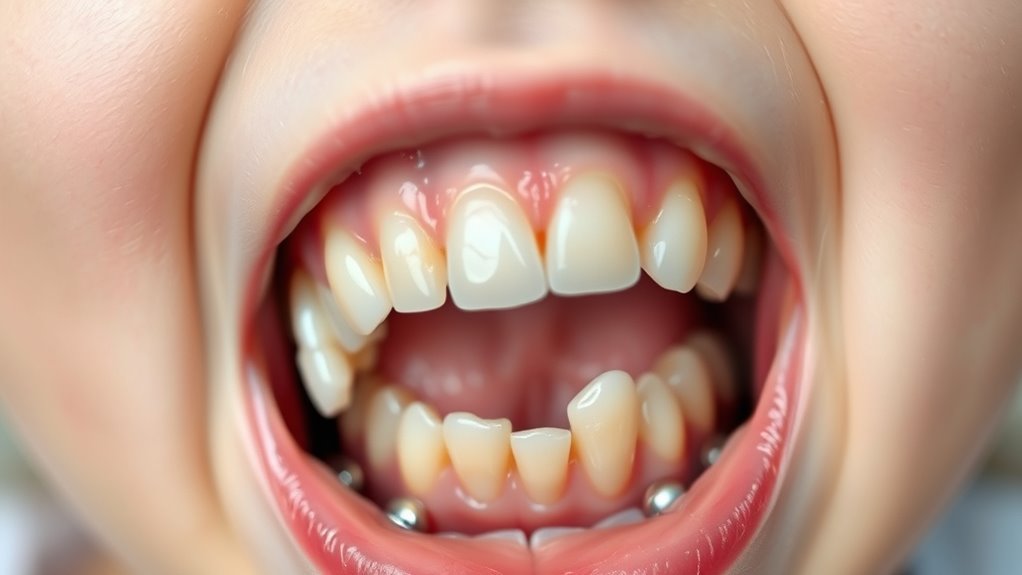Permanent teeth usually start emerging around age 6 and continue into your early twenties, replacing baby teeth and finishing your smile. Some teeth, like molars, come in earlier, while others like wisdom teeth might appear later. The timing varies depending on genetics and health, with delays or early eruptions possible. If you want to understand how your teeth develop and what influences their timing, keep exploring more details below.
Key Takeaways
- Permanent teeth typically begin erupting around age 6, starting with first molars and lower central incisors.
- The full set of 32 permanent teeth usually develops by early adulthood, around ages 17-21.
- Incisors and canines generally erupt between ages 7-12, replacing primary teeth.
- Eruption timing can vary individually due to genetics, space, and developmental factors.
- Some permanent teeth, like wisdom teeth, may emerge as late as the early twenties.
Typical Timeline for Eruption of Permanent Teeth
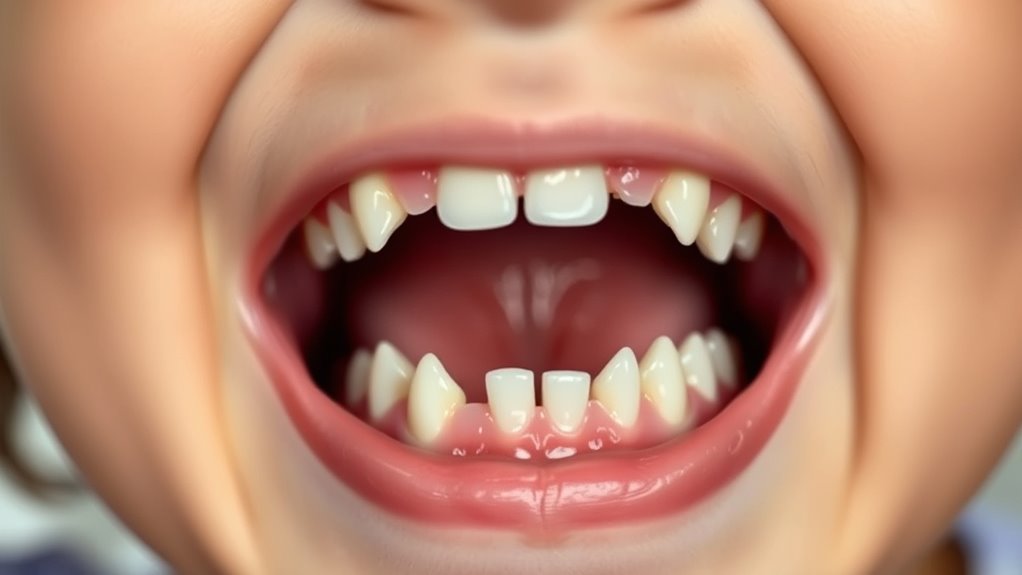
The eruption of permanent teeth follows a predictable timeline that usually begins around age 6. During this period, your primary teeth start falling out as permanent teeth, including molars and incisors, begin to emerge. A typical eruption pattern generally progresses from the back to the front, with first molars appearing around age 6. These molars are vital for jaw structure and don’t replace primary teeth. Between ages 7 and 12, incisors and canines come in, shaping your smile. The full set of 32 permanent teeth, which includes wisdom teeth, typically completes by your early twenties. This dental development stage guarantees your mouth has a full set of functional teeth, following a consistent eruption timeline that guides your oral health journey. Additionally, caring for your dental health during these years can help ensure proper development and alignment.
Early and Delayed Eruption: What to Expect
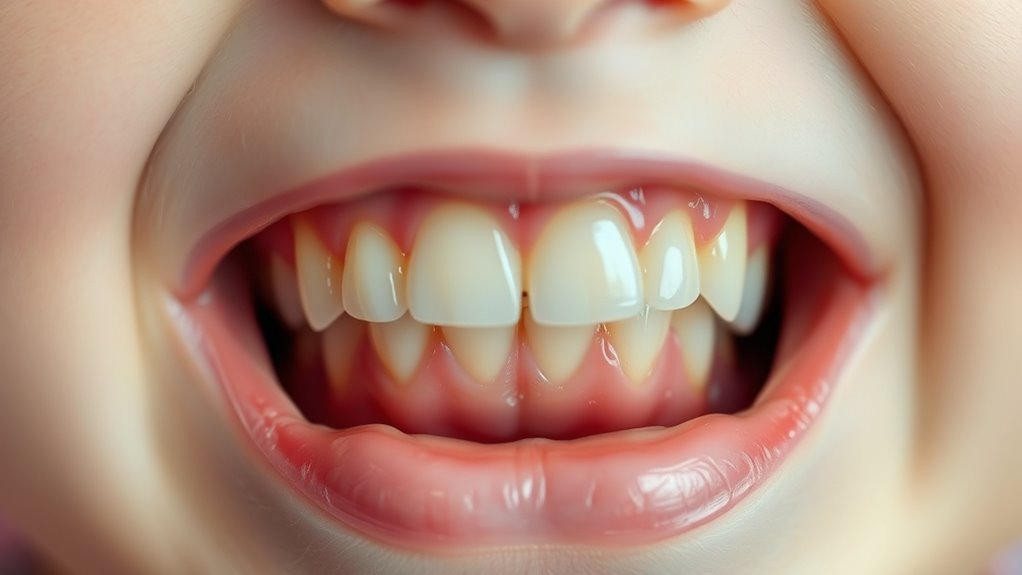
Eruption timing for permanent teeth can vary, with some appearing earlier or later than the typical age range. Early eruption, such as molars coming in before age 6, is possible but should prompt a dental evaluation if markedly earlier. Automation technologies are increasingly being utilized in dental practices to improve diagnostic accuracy and treatment planning. Delayed eruption occurs when permanent teeth don’t emerge by ages 13-14, often due to insufficient space, impacted teeth, or developmental delays. Understanding the eruption chart helps you track expected tooth emergence, but variations are common. If your child’s permanent teeth aren’t visible or erupting within the usual timeframe, a dental assessment is essential to identify potential issues like impacted or congenitally missing teeth. Monitoring eruption timing ensures healthy dental development and helps address problems early, supporting proper alignment and overall oral health. Additionally, genetic factors can influence eruption patterns, making individualized assessments important for accurate diagnosis.
How Permanent Teeth Grow Before Baby Teeth Fall Out
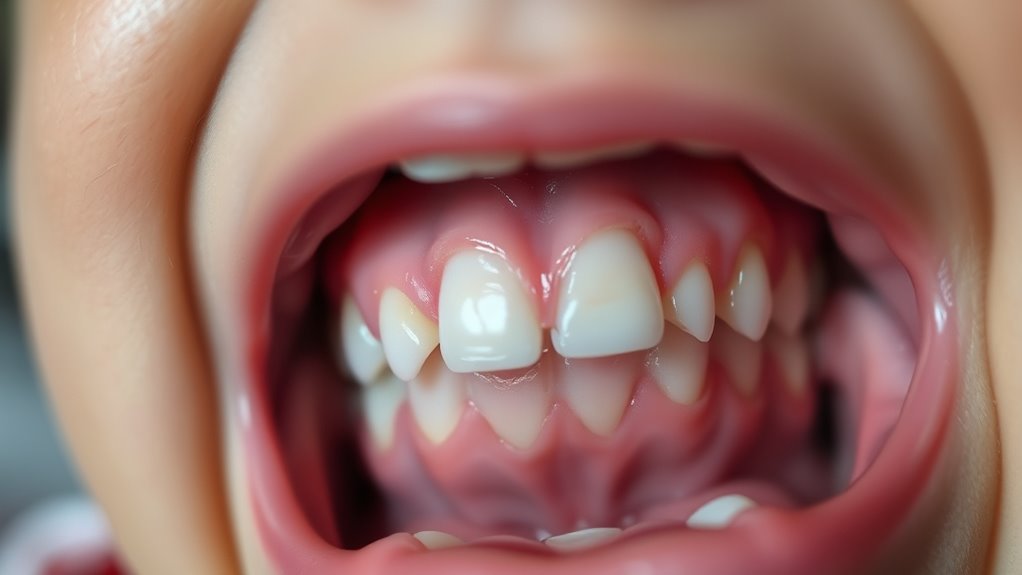
Sometimes, permanent teeth start to emerge before your child’s baby teeth have fallen out, which is a normal part of dental development. During this process, permanent teeth grow behind or in front of primary teeth, creating a double row of teeth called “shark teeth.” This occurs as permanent teeth push against primary roots, causing the baby teeth to loosen and fall out naturally. The timing of eruption is influenced by genetic factors and overall health, which can affect the timing and pattern of eruption. Sometimes, permanent teeth develop behind primary teeth, requiring extraction to ensure proper eruption. The eruption timing varies but generally aligns with typical dental development stages. Here’s a quick overview:
| Aspect | Details |
|---|---|
| Eruption of permanent teeth | Begins before baby teeth fall out |
| Commonly affected teeth | Incisors and molars |
| Double row of teeth | Shark teeth |
| Primary roots involved | Resorbed by erupting permanent teeth |
| Impact on dental development | Usually normal, no problems |
Recognizing Features of Newly Erupted Permanent Teeth
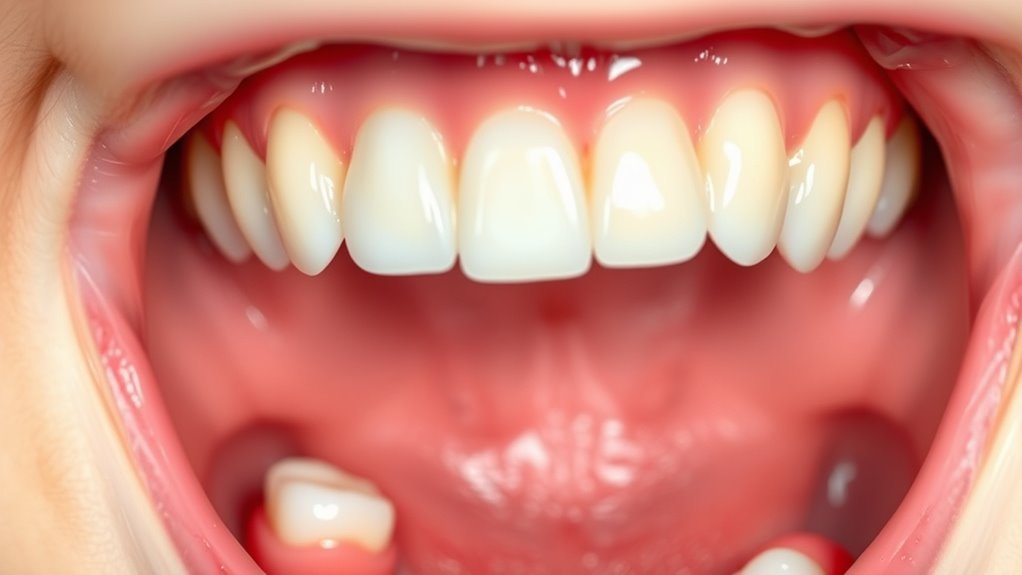
When a new permanent tooth breaks through the gum, it often displays distinctive features that help you recognize it. You might notice mamelons—small, rounded ridges on the incisal edges of incisors—that will gradually wear down. The enamel surface of new permanent teeth can be slightly rough or shiny, with small surface irregularities common during early dental development. These teeth often appear more yellow than primary teeth due to the thicker layer of dentin beneath the enamel surface. The color, along with slight misalignments or uneven edges, can indicate recent eruption. As the tooth continues to erupt, the incisal edges wear down naturally, and the surface smooths out. Recognizing these dental features helps you identify newly erupted permanent teeth and understand their ongoing development. Additionally, early dental development can be monitored to ensure proper eruption patterns and address any concerns promptly, especially since tooth eruption timing can vary among individuals and is influenced by genetic and environmental factors. Regular dental check-ups and monitoring eruption patterns are essential for maintaining healthy teeth and addressing any developmental issues early on. Being aware of dental eruption signs can also help in identifying any deviations from typical eruption processes, and understanding eruption sequence can provide insights into the normal progression of tooth emergence.
Factors Influencing the Timing of Permanent Tooth Development
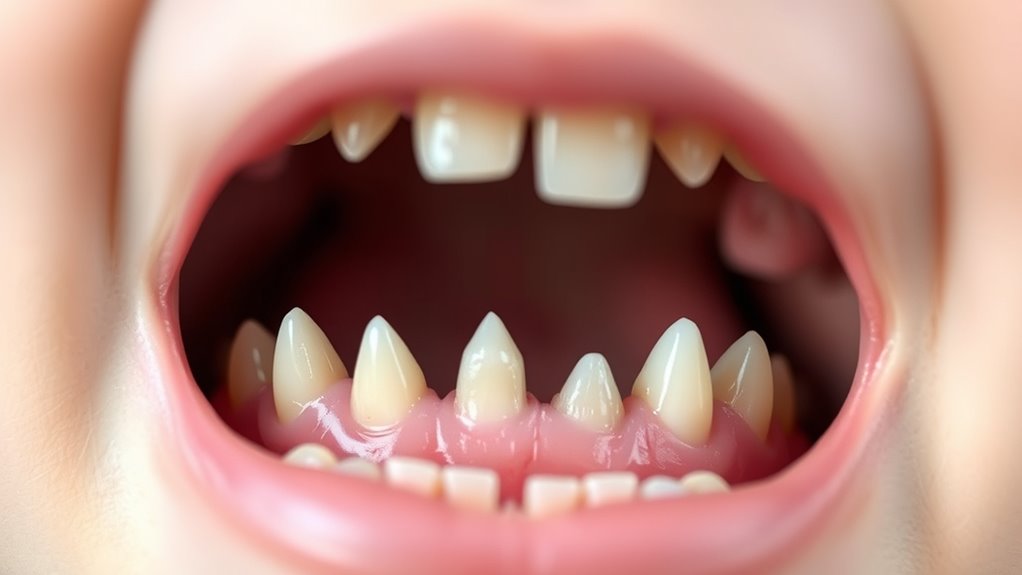
The timing of permanent tooth development is primarily influenced by genetics, which determine the overall growth pattern of your teeth and jaw. Your eruption timing varies based on genetic factors, affecting when primary teeth shed and permanent teeth emerge. Typically, first molars erupt around ages 6-7, often before primary teeth are fully lost. Premolars and canines develop in relation to existing primary teeth and available dental arch space. Developmental delays can occur due to impacted teeth, insufficient space, or issues like hypodontia, which can delay or alter eruption timing. Factors such as early trauma or decay may also influence the process. Understanding these factors helps anticipate when your permanent teeth will come in and highlights why some individuals experience variations in eruption schedules. Genetic influence also plays a crucial role in determining individual differences in tooth eruption timing, as genetic factors contribute significantly to the overall development process. Additionally, dental development stages are essential to understanding the typical timeline for permanent teeth to emerge.
Frequently Asked Questions
What Ages Do Permanent Teeth Come In?
You want to know when your permanent teeth come in. Typically, they start to emerge around age 6, beginning with the first molars.
By age 21, most adults have a complete set of permanent teeth, including wisdom teeth.
Keep in mind, this timing can vary due to genetics, nutrition, or health. Regular dental check-ups can help track your teeth’s development and address any concerns early.
Can a 5 Year Old Lose a Tooth?
Imagine your 5-year-old happily losing a tooth during play—that’s common! Yes, a 5-year-old can lose a tooth, especially primary molars or incisors. This happens because the permanent teeth are developing underneath, pushing the primary teeth out.
It’s a normal part of growing up, but if multiple teeth fall out early or there’s pain, you should see a dentist. Usually, this is just a typical milestone.
Is It Normal for a 2 Year Old to Have No Teeth?
You might wonder if it’s normal for a 2-year-old to have no teeth. Generally, most children start developing primary teeth around 6 months, with full eruption between 6 to 12 months.
If your 2-year-old has no teeth at all, it’s a good idea to consult a pediatric dentist. They can check for any underlying issues, ensuring your child’s dental development is on track and address any concerns early.
Is It Normal to Have Milk Teeth at 14?
Having milk teeth at 14 isn’t typical. Usually, primary teeth fall out between ages 6 and 12 as permanent teeth come in.
If you’re still showing signs of primary teeth at 14, it could mean there’s a delay or issue with your dental development.
You should see a dentist to evaluate what’s happening. They can check if your permanent teeth are erupting properly or if treatment is needed.
Conclusion
As your permanent teeth blossom like a well-tended garden, patience is key. They’ll arrive in their own time, painting your smile with new colors of confidence. Think of this journey as a sunrise—gradual, beautiful, and full of promise. So, trust in the natural rhythm of your mouth’s growth. Before you know it, your smile will shine brighter, a sparkling testimony to the incredible dance of development happening inside.
